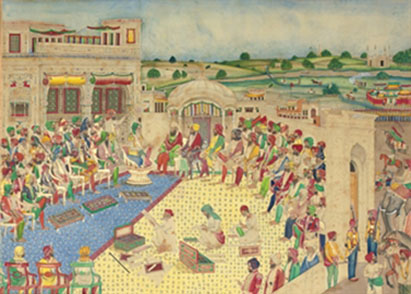Bishan Singh, also known as Baba Bishan Singh, came from a family of artists operating in Lahore and Amritsar in the second half of the 19th century. The family were responsible for painting and maintaining the murals and motifs on the walls of the Sikh holiest shrine, the Golden Temple and it is there that Bishan (and his brother Kishan Singh) learnt his trade. Bishan Singh became particularly famous for his detailed depictions of the Court of Maharaja Ranjit Singh (1780-1839).
Also known as the Lion of the Punjab, Ranjit Singh is the man who, after the Gurus, commands the greatest respect amongst the Sikhs. In 1799 Ranjit Singh captured the Fort of Lahore (built by the Mughal Emperor Akbar in the 1560s) and was declared Maharaja shortly after in 1800. The present painting depicts the Durbar in the Fort of Lahore in immaculate detail, down to the minute precision of the pietra dura decoration of the architecture with its gold tooled embellishments.
Bishan Singh has arranged the Maharajas's immediate family to the left of the composition, including Maharaja Duleep Singh, the boy King who was eventually deposed and brought to England, where he became a favourite of Queen Victoria. To the right of the composition, important courtiers are arranged in order of rank. Such detail is observed that Singh has even painted an extra digit on the right hand of Raja Dhian Singh, the first minister.
Beyond the court is an encampment of Ranjit Singh's army. It is interesting in that we see the way that the army was styled on European lines by his French General, Allard, who joined him after the demise of Napoleon's armies. In contrast however, not a single one of the key Europeans in senior positions in Ranjit Singh's court are depicted. Whilst the French-inspired uniforms are painted with a high degree of accuracy, Bishan Singh, as a devout Sikh, no doubt adopted a puritanical view of the court and would have seen it as an affair not to be marred by a European presence.
At the exhibition of arts and crafts held at Lahore in 1864, Bishan Singh showed ten pictures including 'Darbars of Ranjit Singh, Sher Singh and the Municipal Committee, Amritsar' (W.G.Archer, Paintings of the Sikhs, London 1966, p. 61). These attracted the attention of Baden-Powell and Percy Brown who commented that 'the perspective of the buildings is incorrect but the figure drawing is admirable. The colour is tasteful and rich and likenesses are good and the expression is varied and truthful' (B.H. Baden-Powell, Handbook of the Manufactures and Arts of the Punjab, Lahore 1872, pp. 354-55).
A comparable work, probably also attributable to Bishan Singh, depicts 'Dost Muhammad being received by Sher Singh in Lahore on his way to regain the throne of Kabul', and is in the Kapany Collection (published in Susan Strong (ed.), The Arts of the Sikh Kingdoms, London 1999, no. 189, pp. 166-67). Indeed, when we consider that of the ten works that were exhibited by Bishan Singh at the 1864 Lahore arts and crafts fair, one depicted the court of Sher Singh, the possibility arises that this was amongst them.
A self portrait of the artist was sold at Bonhams, 25 October 2007.
Article courtesy: www.christies.com
 |
|

THE COURT OF RANJIT SINGH
(1836-CA.1900), LAHORE, INDIA, CIRCA 1864
Gouache heightened with gold on thick paper, set in the Fort of Lahore on the terrace of the ornate building with entrance arch in the lower right hand corner and main buildings in the upper left, Ranjit Singh sits towards the centre on his gold throne surrounded by brightly clad family members and courtiers, in the background a hilly landscape with further encampment, with gold, blue and black outer rules obstructed by mount, signed in Gurumuki on a fragment of the surviving cover sheet, 'Bishan Singh Musavar Bannee', buildings and soldiers
Miniature 14 7/8 x 20½in. (37.5 x 51.9cm.)
This 144 year old miniature was auctioned at Christies on 7th Oct. 08 at London. The reserve price was $140,560 - 175,700 while it was sold for $233,587. |

